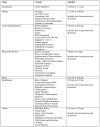Perceived impact of human subjects protection training on community partners in community-based participatory research
- PMID: 25152106
- PMCID: PMC4175404
- DOI: 10.1353/cpr.2014.0023
Perceived impact of human subjects protection training on community partners in community-based participatory research
Abstract
Background: Human subjects protection training (HSPT) is a requirement of institutional review boards (IRBs) for individuals who engage in research. The lack of HSPT among community partners may contribute to power imbalance between community and academic members of community-based participatory research (CBPR) partnerships. The Rochester Healthy Community Partnership (RHCP) is an established CBPR partnership in Minnesota that works primarily with immigrant and refugee populations.
Objective: We sought to describe the implementation and evaluation of HSPT among community members of a CBPR partnership.
Methods: Seven community partners participated in HSPT through adaptation of an existing institutional program. Evaluation of program acceptability was measured through a 5-item survey (5-point Likert scales). A focus group with all seven participants was conducted to evaluate the impact of training on perceptions of research, characteristics of a successful program, and potential value of training to CBPR partnerships. Coding and inductive analysis were done on the transcript with NVIVO-9 software.
Results: The HSPT program was highly acceptable (mean score, 4.5 ± 0.2). Focus groups revealed that training implementation should be done as a cohesive group with the opportunity to discuss concepts as they pertain to partnership projects. Training fostered an encouraging and safe environment, accommodated diverse learning styles, and promoted interaction. Participants reported improved trust in research as a result of the training. Perceived impact of the training on the CBPR partnership included improved transparency and enhanced camaraderie while establishing essential knowledge required for community leaders.
Conclusions: HSPT is feasible among community members of a CBPR partnership, and may improve perceptions of research while strengthening capacity of partnerships to impact community health.
Figures
Similar articles
-
Capacity building through focus group training in community-based participatory research.Educ Health (Abingdon). 2011 Dec;24(3):638. Epub 2011 Dec 4. Educ Health (Abingdon). 2011. PMID: 22267359 Free PMC article.
-
A realist evaluation of community-based participatory research: partnership synergy, trust building and related ripple effects.BMC Public Health. 2015 Jul 30;15:725. doi: 10.1186/s12889-015-1949-1. BMC Public Health. 2015. PMID: 26223523 Free PMC article.
-
Establishing New Community-Based Participatory Research Partnerships using the Community-Based Participatory Research Charrette Model: Lessons from the Cancer Health Accountability for Managing Pain and Symptoms Study.Prog Community Health Partnersh. 2018;12(1):89-99. doi: 10.1353/cpr.2018.0010. Prog Community Health Partnersh. 2018. PMID: 29606697 Free PMC article.
-
Immigrants as Research Partners: A Review of Immigrants in Community-Based Participatory Research (CBPR).J Immigr Minor Health. 2017 Dec;19(6):1457-1468. doi: 10.1007/s10903-016-0474-3. J Immigr Minor Health. 2017. PMID: 27491305 Review.
-
Worth the Risk? Muddled Relationships in Community-Based Participatory Research.Qual Health Res. 2016 Jan;26(1):69-76. doi: 10.1177/1049732315618660. Epub 2015 Nov 26. Qual Health Res. 2016. PMID: 26612889 Review.
Cited by
-
Diabetes Knowledge, Attitudes and Behaviors Among Somali and Latino Immigrants.J Immigr Minor Health. 2016 Dec;18(6):1432-1440. doi: 10.1007/s10903-015-0335-5. J Immigr Minor Health. 2016. PMID: 26706471
-
Healthy Immigrant Families: Randomized Controlled Trial of a Family-Based Nutrition and Physical Activity Intervention.Am J Health Promot. 2018 Feb;32(2):473-484. doi: 10.1177/0890117117733342. Epub 2017 Nov 29. Am J Health Promot. 2018. PMID: 29186984 Free PMC article. Clinical Trial.
-
Community-Partnered Research appraisal tool for conducting, reporting and assessing community-based research.BMJ Open. 2024 Apr 25;14(4):e081625. doi: 10.1136/bmjopen-2023-081625. BMJ Open. 2024. PMID: 38670613 Free PMC article. Review.
-
Rochester Healthy Community Partnership: Then and now.Front Public Health. 2023 Jan 10;10:1090131. doi: 10.3389/fpubh.2022.1090131. eCollection 2022. Front Public Health. 2023. PMID: 36703848 Free PMC article.
-
Community-Engaged Bidirectional Crisis and Emergency Risk Communication With Immigrant and Refugee Populations During the COVID-19 Pandemic.Public Health Rep. 2022 Mar-Apr;137(2):352-361. doi: 10.1177/00333549211065514. Epub 2022 Jan 13. Public Health Rep. 2022. PMID: 35023414 Free PMC article.
References
-
- Israel BA, Schulz AJ, Parker EA, Becker AB. Review of community-based research: assessing partnership approaches to improve public health. Annu Rev Public Health. 1998;19:173–202. - PubMed
-
- Wallerstein NB, Duran B. Using community-based participatory research to address health disparities. Health Promot Pract. 2006;7:312–23. - PubMed
-
- Schulz AJ, Krieger J, Galea S. Addressing social determinants of health: community-based participatory approaches to research and practice. Health Educ Behav. 2002;29:287–95. - PubMed
-
- Boser S. Power, ethics, and the REB: Dissonance over human participant review of participatory research. Qualitative Inquiry. 2007;13:1060–74.
MeSH terms
Grants and funding
LinkOut - more resources
Full Text Sources
Other Literature Sources

